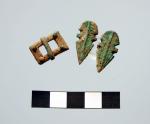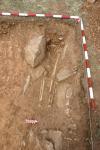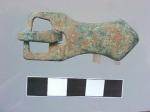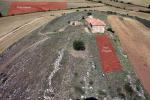Summary (English)
The Visigothic necropolis of Cubillejo de la Sierra (Guadalajara) extends over a spur with a plateau surface and abundant limestone outcrops; it is located next to a chapel built during the Medieval Age whose arrangement suggests that its original plant was linked to this cemetery.
The work carried out shows that the burials are very shallow and due to their position and concentration more than fifty tombs could be stored. All offer similar features: a pit enclosed by large stone slabs with skeletons inside placed in a supine position, with their arms on the abdomen or parallel to the trunk and oriented towards a northwest-southeast direction. The grave objects are few but significant; they include a belt buckle of rigid bronze, two shield-shaped fixtures and numerous iron nails presumably from the coffins, because fragments of wood have also been recovered from beneath the skeletons.
The necropolis indicates a continuous settlement in the area for several centuries. The remains of a village from the Early Iron Age have been detected below it; a few meters away is the Celtiberian-Roman oppidum of Los Rodiles; the Roman villa of La Vega is located at the foot of the hill, occupated in High and Late Roman Imperial times, which could have served as a habitat in the late Late Roman Age.
In these regions of the Kingdom of Toledo few dwelling places are known; urban life was poor, apart from Recopolis and Segontia and, in addition, there have been few recent excavations. In the immediate surroundings of Cubillejo there are ancient references of other cemeteries of the time, such as Establés and Villel de Mesa, as well as faint news of others in Anguita and Corduente.
Therefore this new site expands the available information and indicates that there was a rural settlement in these areas, more abundant that what has been thought previously, and it opens up to new perspectives of study the Late Roman period in the peninsular interior regions, hitherto little known.
(translation by Esther Casares Carmona)
- Emilio Gamo Pazos
Director
- Emilio Gamo (Universidad Complutense de Madrid)
- Marta Chordá (Centro de Estudios Celtibéricos de Segeda)
- Mª Luisa Cerdeño (Universidad Complutense de Madrid)
Team
Research Body
- Universidad Complutense de Madrid
Funding Body
- Junta de Comunidades de Castilla-La Mancha. Consejería de Cultura y Deportes. Cursos prácticos para estudiantes






![Download [PDF]](/excavation/skins/fasti/images/results/download_sml.png)


